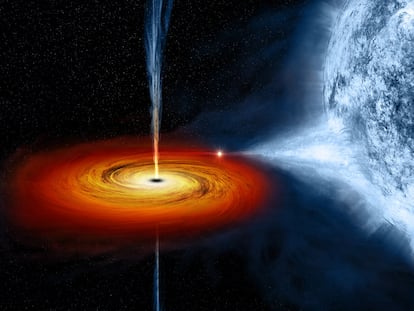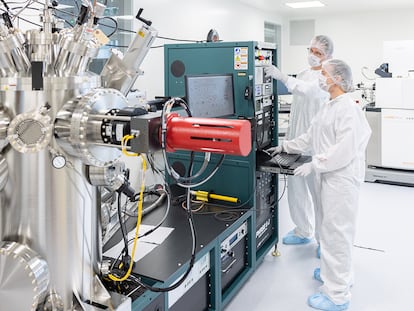Can information travel to the past?
Wormholes that function as time machines are a theoretical possibility within the laws of physics

When I read today’s question, I thought “why phrase it like that, instead of asking if it’s possible to travel back in time?” But I love it as-is. What occurred to me is that the reader who asked this question must think that when it comes to teleportation, as a complex organism, you’re not going to gamble with your life, because on the other side, you would have to be put back together again. Whereas, with a message, if you send it digitally through 0′s and 1′s, time travel might be easier.
There is a very cool paradox about time-traveling messages that is often used in the field of quantum information. The paradox is as follows: someone writes a book in the past that solves all of the problems of humanity: goodbye to wars, goodbye to diseases. In the future, you read the book and say to yourself, “This person is my idol. I’m going to travel back in time to meet her.” You travel back in time and you meet this person, but when you meet her, she says: “I have not written any book.” You show it to her and insist: “Yes, yes, look, this is the book that you are going to write.” And then you give her the book, and she publishes it. That information has traveled back in time, and that person has received it. But where did that information come from? Where was it generated, in the past or the future?
That is the formulation of this question. And to answer it, I am going to explain why we cannot send information to the past. I’ll start with the idea that we can send information to the future, for example, by writing a book. But not to the past. Firstly, because we don’t have a time machine, at least, not year. And secondly, is it possible to build a time machine? At the theoretic level, it is. From a mathematical point of view, it is possible. Wormholes, in theory, allow us to build this machine.
A wormhole is a hypothetical structure in the form of a tube whose open ends would be at two different points in space-time. Moving through the wormhole would make it possible to go from one to the other of those points, so, also hypothetically, it would allow for time travel. But, for the moment, no evidence has been found that space-time actually contains these structures, so this is merely a theoretical possibility.
This is the theoretical field in which I have worked, and in my case, I did that work with a wormhole. A wormhole of this kind that works as a time machine is a theoretical possibility that can be constructed within the laws of physics. But in reality, it’s not possible, because on one hand, all constructions of time travel require something completely exotic, an exotic matter or an exotic space. And by exotic, I mean it’s not something that we know from our physical world like matter or energy or any of the other systems we know. I mean, you can think, theoretically, that maybe you could build that machine with negative energy, but in our world, we have never seen anything with negative energy or negative mass. Furthermore, if you have a time machine and you try to put something in there, what happens? Even if you managed to build that machine with the necessary exotic matter, putting something into one of those machines so that it comes out the other side, surely, winds up destroying that information.
To sum up: the paradox is easily solved, since even if I have a wormhole that works as a time machine, when I introduce information to the wormhole, it is as if there was a wall there that destroys the message that I wish to send.
Time machines, therefore, would be very difficult to build because of the challenges in obtaining the necessary exotic matter. But even if you built them, they have horizons and forces operating at their entrance that would prevent anything from entering and leaving unharmed. So even if, theoretically, it could be built, it would not be effective, because it could not be used for anything.
Ana Alonso-Serrano is a researcher at the Humboldt University of Berlin and at the Max Planck Institute for Gravitational Physics in Potsdam, Germany.
Sign up for our weekly newsletter to get more English-language news coverage from EL PAÍS USA Edition
Tu suscripción se está usando en otro dispositivo
¿Quieres añadir otro usuario a tu suscripción?
Si continúas leyendo en este dispositivo, no se podrá leer en el otro.
FlechaTu suscripción se está usando en otro dispositivo y solo puedes acceder a EL PAÍS desde un dispositivo a la vez.
Si quieres compartir tu cuenta, cambia tu suscripción a la modalidad Premium, así podrás añadir otro usuario. Cada uno accederá con su propia cuenta de email, lo que os permitirá personalizar vuestra experiencia en EL PAÍS.
¿Tienes una suscripción de empresa? Accede aquí para contratar más cuentas.
En el caso de no saber quién está usando tu cuenta, te recomendamos cambiar tu contraseña aquí.
Si decides continuar compartiendo tu cuenta, este mensaje se mostrará en tu dispositivo y en el de la otra persona que está usando tu cuenta de forma indefinida, afectando a tu experiencia de lectura. Puedes consultar aquí los términos y condiciones de la suscripción digital.
More information
Últimas noticias
Most viewed
- Reinhard Genzel, Nobel laureate in physics: ‘One-minute videos will never give you the truth’
- Oona Chaplin: ‘I told James Cameron that I was living in a treehouse and starting a permaculture project with a friend’
- Pablo Escobar’s hippos: A serious environmental problem, 40 years on
- Why we lost the habit of sleeping in two segments and how that changed our sense of time
- Chevy Chase, the beloved comedian who was a monster off camera: ‘Not everyone hated him, just the people who’ve worked with him’










































